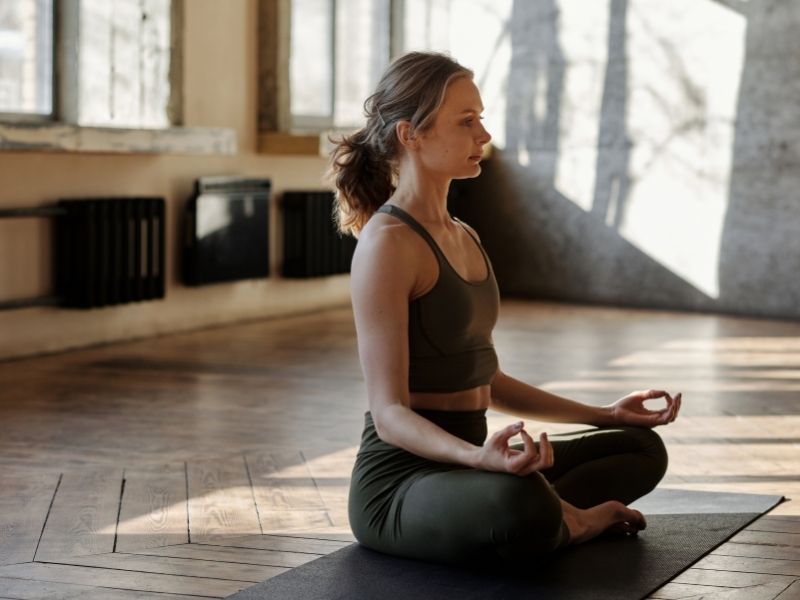Yoga for SI Joint Pain – Here Are The Best Poses

Yoga for SI joint pain relief can be very helpful, especially due to the many positive effects that yoga practice offers. However, no matter what movement system you participate in, everything should be modified to individual needs.
Whenever we approach the topic of SI joint dysfunction and/or pain, we have to include the lumbar spine and the hips. Due to the extremely minimal amount of movement that is present (if at all), any movements that we focus on should be directed at the positioning of the lumbar spine and hip complex. The result of these adjustments will affect the sacroiliac joint region.
In this post we’ll explore some of the most useful yoga poses for those dealing with SI joint pain, and also some movements that demand more awareness and caution when performing.
Best 4 Yoga Poses For SI Joint Pain
Cat Cow
The cat-cow pose is a simple movement performed on all fours and emphasizes flexion + extension of the spine. In the all-fours position, there is less influence from the legs and associated muscles on postural distortion, thus it offers a safe way to both test these movements in an unloaded position, as well as identify any potential discomfort.
Child’s Pose
Child’s pose can help with stretching the spinal extensor muscles, as well as encourage posterior pelvic tilting. In this position, since inhalation will be somewhat restricted in the abdominal region, a stretch can be felt in the back ribs which is often helpful.
There are multiple potential challenges with this position, however, mainly due to hip, knee and/or ankle restrictions. This movement can be modified by doing a simple search on Youtube if needed.
If you have sensitivity to spinal flexion, be sure to consult with your physical therapist for how to use this position.
Low Lunge
The low-lunge pose is helpful for stretching the hip flexor muscles (psoas, iliacus, rectus femoris, TFL). These muscles are often short and tight. When both sides are short, the pelvis moves into more anterior pelvic tilt. When one side is tighter it pulls the pelvic bone (ilium) forward and turns the pelvis toward the lengthened side.
Either of these positions, when in excess, can increase lumbar spine extension and therefore be a source of lumbo-sacral region discomfort. This makes the low-lunge a useful pose.
One thing to note, if there is a discomfort to lumbar extension, the pelvic tilt should be controlled as one moves into the hip flexor stretch position. Meaning, a posterior pelvic tilt should be maintained. If not, its easy to hyper extend the lumbar spine through anterior pelvic tilt.
Seated Forward Bend
The seated forward bend focuses on stretching the hamstrings primarily, and if the lumbar spine is flexed forward, the lumbar extensors will be lengthened.
Perhaps the biggest benefit of this pose is learning to control the movement of the pelvis to introduce a hamstring stretch WITHOUT flexing forward at the lumbar spine.
Yoga Poses To Avoid With SI Joint Pain
Generally speaking, any specific movement could be fine OR problematic for any specific person. This is why it’s hard to come up with a list of yoga poses to avoid. A better way to frame this is a “list of yoga poses to be cautious with”.
Poses that require deep forward folding
Any pose that requires a very deep forward folding (lumbar spine flexion) could be problematic for those dealing with flexion intolerance. This means pain/discomfort when rounding the lumbar spine due to potential disc pathology for example.
These positions should be modified to reduce the amount of flexion to a tolerable level or omitted if your therapist advises against it.
Poses that require deep twisting
Generally speaking twisting of the spine is normal and healthy. However some individuals may have difficulty controlling lower lumbar spine and/or hip movement which may create unwanted stress across the SI joint region.
Another common problem is lack of thoracic spine mobility, thus increasing the demands of rotation from the lower spinal segments, creating discomfort.
Poses that require a super wide stance
Yoga poses that require a really side stance can be problematic due to which pose, and the individual’s specific sensitivities. For example, a wide stance squat position is often very comfortable, but a very wide stance lunge-type position combined with flexion and/or rotation may be problematic (think Warrior or Triangle).
Caution should be practiced with these positions.
Poses that require single leg standing
One of the common features of SI joint pain is difficulty putting weight on the irritated side. For obvious reasons, doing single leg balance poses on that side need to be modified or avoided until the discomfort is reduced.
Conclusion
Yoga for SI joint pain can be a very helpful way to reduce discomfort and encourage normal resting muscle tension. Precautions should be taken and modifications to any movement as needed based on recommendations from a qualified therapist and individual needs.
Related Articles
5 Special Tests To Uncover SI Joint Dysfunction
How To Know If Your SI Joints Are Causing Your Pain
Sacroiliac Joint Belts – Do They Work?
How To Sit With SI Joint Pain?
Sam Visnic
I’ve spent my life studying the fundamental aspects of human health with a focus on movement and clinical massage therapy. In a world of specialists, surgical procedures, drugs and quick fix remedies, I’m committed to finding and developing strategies that help people stuck at the “gap”. Over the last 20 years I’ve studied dozens of systems and methodologies for uncovering the root cause of aches and pains, along with postural and movement issues. Pain science, the art and science of hands-on soft tissue massage techniques, myofascial release, and coaching movement is essential in my practice. Integrating different methods but above all deciphering WHEN to use different techniques with different people and situations, along with integration of movements that people want to be able to do again is the key to long term success with my incredible track record with clients. Understanding the various elements that contribute to conditions and the power of communication and education makes my Release Muscle Therapy program separate from other hands-on therapy approaches.
Blogs You May Be Interested In
Categories
-
Deep Gluteal Pain Syndrome
-
Deltoids
-
Fallbrook
-
Foam Rolling
-
Glutes
-
Hamstrings
-
Hypnosis For Pain
-
Lats
-
Levator Scapulae
-
Lifestyle
-
Massage Therapy
-
Mobility
-
Movement and Exercise
-
Murrieta
-
Muscles
-
Nutrition
-
Obliques
-
Pain
-
Pectorals
-
Piriformis
-
Plantar Fasciitis
-
Product Review
-
Psoas
-
Quadratus Lumborum
-
Quadriceps
-
Rhomboids
-
Serratus Anterior
-
SI Joint
-
Sternocleidomastoid
-
Stretching
-
Subscapularis
-
Temecula
-
TMJ
-
Trapezius
-
Uncategorized
















